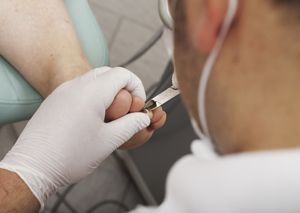Diabetic Foot Problems
Providing Diabetic Foot Care
to the Niagara Falls, NY Area
Many people around the world struggle with diabetes. Having too much glucose in your blood for long periods of time can cause foot problems. When people have uncontrolled diabetes, it can cause diabetic neuropathy. This can damage nerves. Once the nerves have become damaged, people lose the ability to feel heat, cold, or pain in their feet. Another problem that is caused by diabetes is peripheral vascular disease. This disease affects blood flow. Poor blood flow can lead to longer recovery times for sores or cuts to heal. Having an infection that won’t heal puts people at risk for ulcers and gangrene.
Diabetic foot care is crucial to keeping your feet healthy. At Dr. Richard Sawicki, our foot doctor strives to provide comprehensive treatment plans for diabetic foot problems. No matter your age or foot issue, we will help you find relief. Contact us today to schedule an appointment! We proudly provide a variety of foot care services to the Niagara Falls, NY area, including not only diabetic foot care but also treatment for
ingrown toenails,
foot warts,
heel spurs,
plantar fasciitis, and more.

Common Diabetic Foot Problems:
There are various foot problems that can occur in people who are diabetics. Some can be treated with medications while others will require a foot surgeon. Keeping your feet healthy is important for your overall health. Noticing the signs of an abnormality or infection is key to preventing the problem from worsening. Check out the following section to gain a better understanding of diabetic foot problems.
Athlete’s Foot
This is a fungus that causes the foot to appear red, itch, and crack. The cracks create a space for germs to get into the skin and cause an infection. A podiatrist will prescribe medication to kill the fungus.
Nail Fungal Infection
Nails that appear discolored, thick, or brittle are often infected. An injury to the nail can cause a fungal infection to grow. These types of infections can be difficult to treat. Oftentimes, a podiatrist will prescribe medication but if that doesn’t help, the damaged nail must be removed.
Calluses
This is a build-up of hard skin, which is usually found on the underside of the foot. They form due to the uneven distribution of weight. Calluses can also be caused by poor-fitting shoes or other skin problems. It's important to care for calluses properly. After a shower, use a pumice stone to gently remove the built-up hard tissue. Wearing comfortable shoes with cushioned inserts can also help. A podiatrist can prescribe a medication to help soften the hard tissue.
Corns
Hard skin that’s developed near a bony area on the toe or between the toes is known as a corn. These can form due to everyday wear of shoes on the feet. Using a pumice stone after a shower will help to remove the hard skin. Medication can also be prescribed by a podiatrist to soften the corn.
Bunions
A bunion is formed when the big toe bends toward the second toe. This can cause the area where the big toe joins the foot to become red and callused. This spot may also stick out and become hard. They’re often caused by wearing high-heel shoes that are narrow. A podiatrist can use a device to separate the big and second toe. If the bunion is causing serious pain, a foot surgeon will have to realign the toes.
Dry Skin
Skin that’s dry can easily crack, which creates a space in the skin for germs to enter. A podiatrist can recommend soaps and lotions to keep the skin soft and moisturized.
Ulcers
An ulcer on the foot is a break in the skin or a deep sore. Just like any cut, there’s a risk for an infection. Ulcers can develop from minor scrapes, cuts that are healing slowly, and shoes that don’t fit properly. A foot doctor will be able to recommend the best care for the ulcer.
Hammertoes
When a toe is bent because of weakened muscle, it’s called a hammertoe. This problem can be caused by genetics or shoes that are too short. A foot doctor may splint the toe in order to straighten it. It’s also important that people with hammertoes wear shoes that fit properly. In some cases, a foot surgeon will need to perform a procedure to straighten out the toes.
Ingrown Toenails
An ingrown toenail is when the edge of the nail grows into the skin. This can cause extreme pressure and pain on the sides of the toe. It can cause inflammation, pain, drainage, and infection. They often develop because of the pressure that shoes put on the nail. Properly trimming the nails will prevent the development of ingrown toenails. If they become infected, treatment from a podiatrist is necessary to prevent the infection from spreading. In some serious cases, a foot surgeon will have to remove the ingrown part of the toenail and growth plate.
Plantar Warts
These are often found on the heel or “ball of the foot.” They are similar looking to a callus. Plantar warts may grow in clusters or by themselves. They are caused by a virus that infects the out layer of skin on the soles of the feet. They can be extremely painful without proper treatment from a specialist. A foot doctor will be able to determine the best way to remove them.
Contact Our Office in Niagara Falls, NY for Quality Diabetic Foot Care Services
If you’re struggling with a diabetic foot problem, it’s time to seek treatment from a podiatrist. At Dr. Richard Sawicki, our team has years of experience in providing quality diabetic foot care for residents across Niagara Falls, Lockport, NY and the surrounding areas. Have no doubt, that our podiatrist will be able to treat and manage your diabetic foot problems.
Contact our office to schedule an appointment with our foot doctor.
